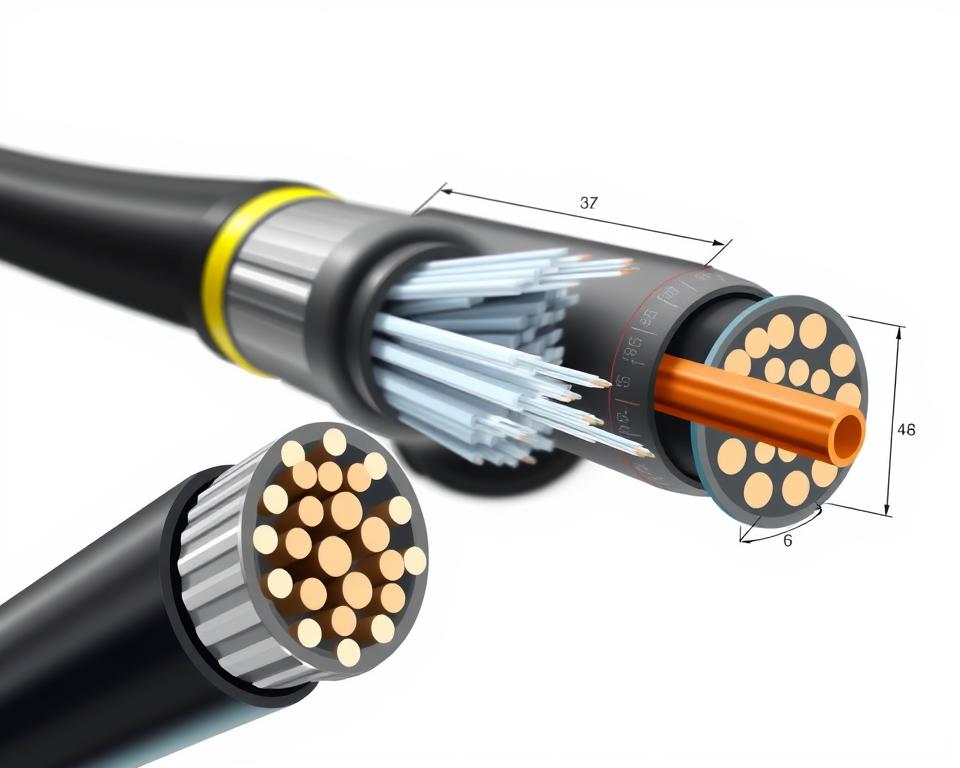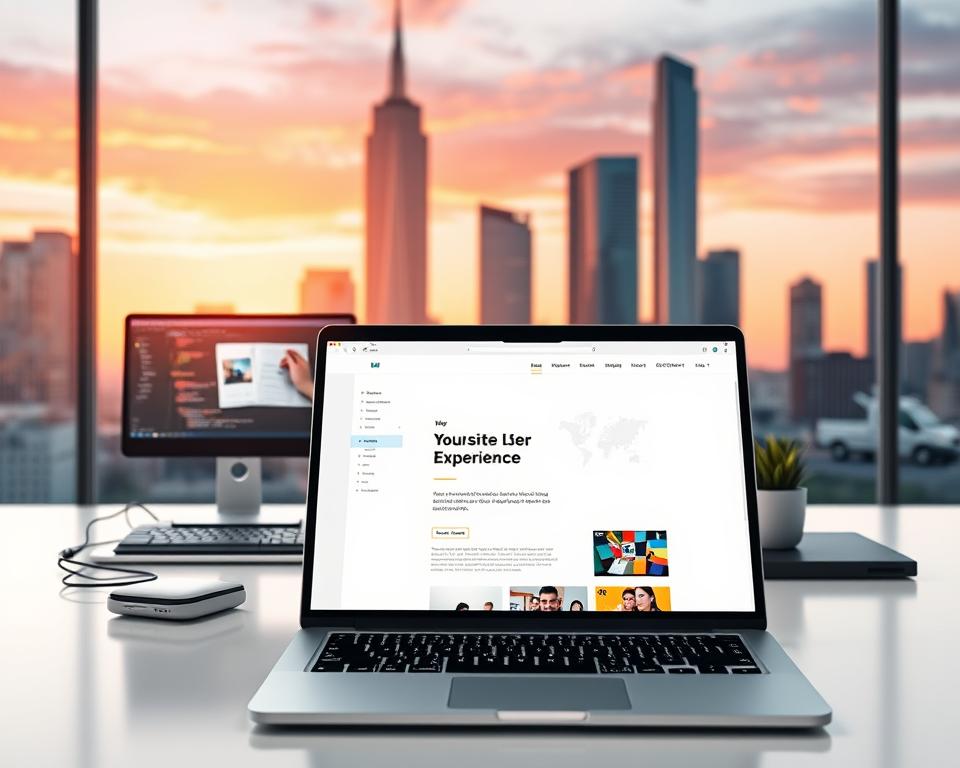Fiber-to-the-Home Cable Production: Step-by-Step Manufacturing Process
Quick fact: over seventy percent of new broadband deployments in the U.S. now rely on fiber networks that require precise manufacturing to achieve required performance.
Shanghai Weiye OFC Equipment handles complete FTTH cable production line manufacturing, from sourcing brand fibers like Fujikura® or Corning® SMF-28e to final test reports that deliver 100% QA.
Our drop cable designs suit aerial, ducted, and direct-buried installation, with low-smoke zero-halogen (LSZH), polyvinyl chloride (PVC), and PE jacket options and arrangements from 1–4 cores. We supply OS1/OS2 and OM2–OM4 grades plus ITU-T G.652D and ITU-T G.657 variants, Pantone-matched sheath colors, and custom logo printing.
Automated machines and precision equipment keep line speed steady and keep repeatability high. Typical lead times are four to five days for orders under 100 km and 7–10 days for < 500 km, with an MOQ of 1 km and warranty for free replacement on quality issues.
Continue to understand how materials plus testing and support combine to lower lifecycle cost and pair the right product with your network.
- Shanghai Weiye OFC Equipment provides end-to-end manufacturing and lab testing for U.S. deployments.
- A range of jacket options and optical grades fit varied installation environments.
- Automated production lines ensure stable quality and reliable optical performance.
- Fast lead times, low MOQ, and recognized brand fibers support reliable procurement planning.
- Complete reports and warranty back product reliability and documentation needs.
Specialized FTTH Manufacturing by Shanghai Weiye OFC Equipment
When deadlines and performance are critical, Shanghai Weiye OFC Equipment delivers tailored drop solutions with complete test documentation.
As a focused supplier and manufacturer, Shanghai Weiye OFC Equipment pairs purpose-built equipment with tight material control. We provide customized service and products for residential/MDU deployments. Every order comes with full QA coverage and full test reports.
Our lab performs high-temperature, salt spray, and vibration testing to verify durability. Jacket options cover LSZH, PVC, and PE. Designs include bow-type flat and figure-8/self-supporting styles and support brand fibers such as Fujikura and Corning® SMF-28e.

- Controlled production lines and in-process checks for shipments with audit trails.
- Engineering support for specification reviews, trials, and volume ramp.
- Modern fixtures and calibration minimize variation so every cable meets operator standards.
How We Produce FTTH Cable
At Shanghai Weiye OFC Equipment, manufacturing steps are matched to network specs, combining brand fiber choices with strict test routines.
Fiber Selection & Brand Options
We align Fiber coloring machine to minimum bend radius, attenuation, and install environment. Options include OS1/OS2 and OM2–OM4 and ITU-T G.652D, G.657.A1/A2. Brand fibers such as Fujikura and Corning® SMF-28e are offered to satisfy sourcing standards.
Strength Member Options
Strength members employ dielectric FRP or metallic steel wire. FRP is ideal where non-conductivity is necessary. Steel wire provides tensile strength for long-span aerial runs and grounding needs.
Jacket extrusion and process control
Jacket options include LSZH for indoor flame safety, PVC for flexibility and ease of handling, and PE for outdoor UV and moisture resistance. Tight process control of extruder temperature and capstan speed stabilizes line speed and critical dimensions.
| Member | FRP | Metallic Steel |
|---|---|---|
| Primary use | Non-conductive runs | High-tension aerial runs |
| Key benefit | Light, non-corrosive | Very high tensile strength |
| Installation note | Easier terminations | Requires grounding |
Testing & Verification
Inline geometry and concentricity checks operate in-line. Final optical tests confirm attenuation and return loss. Each order includes a full test report and lab results from high-temperature, salt-spray, and vibration tests to confirm handling for drop terminations and field use.
Typical lead times are under 100 km in 4–5 days and 7–10 days for < 500 km. Lot records and first-article approvals provide traceability and compliance for U.S. programs.
FTTH drop cable types and structures we manufacture
Shanghai Weiye OFC Equipment provides a focused portfolio of drop designs that suit both tight indoor routes and exposed aerial spans. Each option pairs tested materials with geometry tuned for field termination and stable optical performance.
The flat bow-type drop keeps a small footprint for risers/ducts. It reduces bend loss for simple routing in MDU corridors and hallways.
Aerial Self-Supporting Options
Self-supporting FTTH drop designs include a support messenger to handle tension. Choose FRP (dielectric) for electrical isolation or steel wire when bonding/grounding and extra tensile strength are required.
Layouts & Strength Members
We offer both dielectric and metallic strength member configurations to match safety and EMI rules. Center loose tube and unitube flat types balance crush resistance and fiber ribbone line for quick termination.
Jackets for Indoor/Outdoor
Jacket choices include LSZH for flame-retardant, low-smoke indoor use and PE for outdoor UV and moisture resilience. Each family is qualified for mechanical/optical performance before shipment.
| Type | Application | Strength member | Jacket |
|---|---|---|---|
| Flat bow-type | Indoor risers and MDUs | FRP (dielectric) | LSZH |
| Self-supporting (aerial) | Aerial spans | FRP/Steel | Polyethylene |
| Central loose-tube | Higher fiber counts | FRP | LSZH or PE |
| Flat unitube | Low-count, easy strip | FRP or steel | LSZH/PE |
Equipment Ensuring Quality and Throughput
Automation with sensor feedback at Shanghai Weiye OFC Equipment cut manual handling and boost throughput for drop patch preparation.
Our production line integrates automated machines that cut and strip drop patch cords to increase output and cut labor variability.
The CLX-BPO2 automated stripper uses PLC + photoelectric control. One cycle is ~1.5 s, giving ~20 terminals per minute in production.
Auto Cut & Strip Capabilities
The equipment strips LSZH/PVC jackets and trims FRP or steel strength members to precise reserved lengths. Cylinder-driven actuators provide quick, repeatable motion and low downtime.
PLC/photoelectric control for precision and repeatability
PLC logic and photoelectric sensors give exact positioning and feedback control. Inline checks feed control charts so operators can adjust drifts before defects grow.
| Feature | Spec | Result |
|---|---|---|
| CLX-BPO2 | Auto-strip, ~1.5 s cycle | High throughput |
| Actuation | Pneumatic cylinders | Fast/reliable motion |
| Material handling | LSZH & PVC; FRP & steel | Clean, accurate preps |
| Process control | PLC/photoelectric with in-line SPC | Stable quality, reduced rework |
- Auto scrap ejection and ergonomic feeders keep the line clean.
- Process control plans capture calibration intervals and critical parameters.
- Integrated assets and trained operators help meet FTTH volume goals without compromising accuracy.
CLX-BPO2 auto-stripping machine capabilities in our line
The CLX-BPO2 brings industrial-grade stripping and trimming to our line, cutting cycle time while keeping prep consistent.
Shanghai Weiye OFC Equipment deploys the CLX-BPO2 to increase throughput and standardize terminal quality. The unit runs at an approximate cycle time of 1.5 seconds, yielding about 20 terminal preparations per minute in production.
PLC and photoelectric control deliver exact detection and repeatable motion. That control keeps strip and stub lengths within tight tolerances.
Throughput & Cycle Time
Typical operation speed is ~1.5 seconds per cycle. This translates to steady throughput under continuous line conditions.
Supported jacket and reserved strength lengths
The CLX-BPO2 strips LSZH and PVC jackets with an adjustable jacket strip length from 17.5–35.0 mm. Reserved strength member stubs are adjustable from 7.0–11.0 mm to match common termination hardware.
FRP & Steel Member Handling
The machine cuts FRP/steel strength elements cleanly while protecting adjacent fibers. Customized cutters are available for nonstandard sizes to maintain precision.
- Auto-eject scrap and sensor-triggered start reduce idle time.
- Compact size (L40 × W18 × H18 cm), 50W at 110–220V, and 11 kg mass simplify cell integration.
- Pneumatic cylinders and PLC/photoelectric control boost reliability and reduce maintenance downtime.
| Spec | Value | Benefit |
|---|---|---|
| Cycle | ~1.5 s (~20/min) | Supports high-volume runs |
| Strip lengths (A) | 17.5 to 35.0 mm | Fits common connector processes |
| Stub (B) | 7.0–11.0 mm | Supports termination strength |
| Power/Size | 110–220V, 50W; 40×18×18 cm | Simple integration |
Using this machine, Shanghai Weiye OFC Equipment standardizes terminal prep so field teams get drop parts install-ready. The CLX-BPO2 helps our production lines meet volume goals without sacrificing quality.
Customized specifications to fit your FTTH system
Shanghai Weiye OFC Equipment configures every order to fit your network requirements and simplify deployment. We combine focused options with predictable schedules so your teams receive ready-to-install products.
Choose 1–4 core designs with single-mode or multimode fiber. Options include OS1, OS2, and OM2–OM4 plus G.652D/G.657 variants to match your optics and connector plans.
We Pantone-match sheath colors for quick field identification and consistent asset tagging.
Jackets, Legends & Branding
Select LSZH/PVC/PE jackets to suit route and safety requirements. Custom legends/logos aid inventory/warranty tracking.
Lengths, Packaging & Special Builds
Standard reel lengths are 1/2/4 km with custom reels and packaging to fit storage/handling. Choose bow-type flat or self-supporting designs and FRP or steel members to meet span and isolation needs.
| Option | Typical | Advantage |
|---|---|---|
| Reel length | 1, 2, or 4 km | Simpler staging and reels |
| Jacket | LSZH, PE, PVC | Indoor/outdoor compatibility |
| Design | Flat bow / Self-supporting | Routing and span flexibility |
As a manufacturer, Shanghai Weiye aligns runs to your schedule and provides docs that detail final specs for easy on-site QA.
Quality assurance, testing, and documentation
Shanghai Weiye OFC Equipment embeds quality checkpoints across the production line so every item ships with recorded acceptance data.
Lab Testing: Heat, Salt Spray & Vibration
Our lab conducts high-temperature exposure, salt spray corrosion, and mechanical vibration to qualify materials and assemblies. These tests recreate field stresses for indoor/outdoor applications.
Per-Reel 100% Reports
Every fiber optic cable ships with a 100% test report that records loss, return loss, and key geometry where applicable. Final QC gates prevent nonconforming shipments before they leave the factory.
Traceability & Compliance
Batch records link tests to reels/serials so audits and claims are easy to verify. Documentation follows common customer templates to accelerate approvals and receiving inspection.
- In-line checks plus final inspection prevent field failures and lower warranty events.
- QA packages include specifications confirmation and formatted test data for quick review.
- Ongoing trend analysis inform preventive maintenance and raise long-term reliability.
| Test | Purpose | Outcome |
|---|---|---|
| Heat exposure | Thermal stability | Validated heat endurance |
| Salt-fog | Corrosion robustness | Outdoor suitability |
| Vibration | Resistance to vibration | Reduced field failures |
FTTH Drop Cable Pricing & Cost Drivers
Budgeting for a drop run starts with fiber and jacket choices and is shaped by volume and customization.
Typical prices range broadly—from about $30–$1,000 per unit—based on fiber grade (G.652/G.657/OM2–OM4), jacket material, length, and design structure.
Materials, Grade, Jacket & Structure
The primary cost drivers are fiber grade, jacket material, and the chosen structure for deployment.
Self-supporting structures and steel members increase material/labor. Custom colors, logos, and print legends add setup and influence price for short runs.
How Volume & Options Affect Cost
Longer put-ups and larger volumes reduce unit cost. Small quantities often include setup charges and higher per-unit charges.
- Line changeovers and custom tooling extend lead time and add to cost.
- Clear RFQs and line scheduling let Shanghai Weiye OFC Equipment align price quotes to delivery windows.
- Frameworks and indexed pricing stabilize budgets over phases.
| Driver | Price impact | Recommendation |
|---|---|---|
| Optical grade | High impact | Balance spec vs. budget |
| Sheath material | Medium impact | Evaluate LSZH vs PE |
| Order length / volume | Large | Consolidate runs to cut unit cost |
Lead times, MOQ, and delivery for the United States
Shanghai Weiye OFC Equipment keeps lead times/logistics clear so planners can align crews and sites. Predictable schedules cut downtime and help control cost when a rollout is underway.
Scheduling & Capacity Planning
Typical production windows run 4–5 days for orders under 100 km and 7–10 days for orders under 500 km. We plan capacity to track your milestones and to keep deliveries on time.
The service team provides updates/tracking so installation teams can plan arrivals. For compressed schedules, we hold contingency capacity to pull in critical-path orders.
Minimum order quantity and why it matters
The MOQ is one kilometer. This reflects line setup such as wire and jacket die adjustments that use startup material and generate scrap.
We review your length and staging plans to select reels to reduce waste/handling. Staggered batches can balance inventory with frequent, smaller deliveries to job sites.
Installation Scenarios & Readiness
On-site conditions dictate whether a self-supporting aerial, ducted pull, or direct-buried run is the best fit for a project.
Aerial vs Duct vs Direct-Buried
For aerial runs, Shanghai Weiye OFC Equipment advises self-supporting designs with correct strength members to manage sag/tension for long-term reliability.
Duct installations perform best with low-friction sheaths and crush-resistant constructs so pulling avoids fiber damage. PE jackets are typical for underground and buried paths where moisture resistance matters.
Direct-buried designs require proper depth control per local codes and moisture barriers to protect the fiber core long-term.
Indoor Distribution and ONT
Indoor riser/plenum routes favor LSZH jackets to meet smoke/flame codes. Flat drop profiles strip cleanly and present controlled stubs for quick ONT termination.
We advise on steel vs FRP (dielectric) strength members based on bonding needs, lightning exposure, and hardware compatibility. Standardized prep from the production line shortens install time and reduces scrap.
| Deployment | Key feature | Installer note |
|---|---|---|
| Overhead | Self-supporting (steel/FRP) | Verify messenger hardware/tension |
| Duct | Low-friction, crush-resistant | Use pull tape and proper lubricant |
| Direct-buried | PE with moisture barrier | Follow depth/warning tape codes |
| Indoor | LSZH with tight-bend support | Maintain bend radius at penetrations |
Our approach delivers a consistent installation across indoor outdoor transitions. That leads to fewer callbacks, faster activations, and reliable field performance for your system.
Support from Spec to Service
Our team coordinates tests, line schedules, and installation guidance to avoid surprises in deployment.
Shanghai Weiye OFC Equipment provides engineering support from early requirements through approved drawings and pre-production builds. We provide doc templates and clear installation notes so field crews share a unified plan.
After-sales service covers rapid response, root-cause analysis, and corrective actions. All products ship with full test reports and traceability to support QA acceptance.
- 24/7 availability for status and technical support.
- Warranty includes free replacement for confirmed quality issues.
- Coordination of line schedules for urgent changes or acceleration requests.
- Configuration control so shipped items match agreed specs consistently.
| Support area | What we do | Outcome |
|---|---|---|
| Tech/Eng | Spec review & pre-production builds | Reduced field issues |
| QA/Testing | Lab trials & 100% test reports | Traceable quality |
| Service | Fast replace + RCA | Minimized downtime |
Conclusion
Choose Shanghai Weiye OFC Equipment for tailored drop builds, short lead times, and traceable quality records.
We deliver customized FTTH drop solutions that pair material choices with validated manufacturing and lab testing. Every reel includes a 100% test report and documented lab trials to support U.S. field acceptance.
A robust production line, including CLX-BPO2-enabled prep machines, cuts variability and shortens turnaround. Our equipment set standardize strip/stub lengths so installers see consistent results at turn-up.
From fiber selection through jacket, printing, and packaging, we balance performance and cost to extend service life. Dedicated support covers scheduling/logistics/after-sales so your deployment stays on plan.
Get in touch with Shanghai Weiye OFC Equipment to align specs, timeline, and volume. We stand behind every shipment with lab validation and responsive support.








